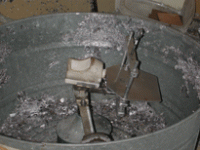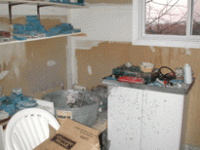Hi, Cigarboy, and welcome to the forum!
I''ve been running around the past couple of days, and am getting caught up now on the forum. I'll add that I agree with everything that's been noted here, and some of my own experience.
As to molds, there are commercially available molds made of silicon rubber, should you choose to experiment with the basic process of melting metal and casting, and leave mold-making for the next phase.
KV (Kilted Vampire) mentioned Dutkins, who is Rich Dutkin of Dutkin's Collectables. He has a wide range of molds, including his own Little Army molds, as well as figures, too, sells online/via mail and at shows, his website is
www.dutkins.com. His catalogs are available at the site as downloads in PDF.
You might also try Prince August (
www.princeaugust.ie), who have an extensive line of molds, covering many periods of history, and some fantasy, too. They sell molds for fully round figures, as well as smaller halfround figures suitable for wargaming, and some in classic wargame scales.
If you don't want to deal with international postage from Ireland, the Dunken Company (
www.dunken.com) in Texas carries Prince August molds (that's where I got mine, when I broke into casting), among other lines of molds.
Finally, another source of molds is Castings, Inc (
www.miniaturemolds.com), who carry an extensive line of molds.
All of those suppliers also sell various brands of casting metal, and you can get mold-making supplies from most of them as well, if you decide to start making your own molds, too.
As to metal, I use lead and old linotype metal, in various combinations, depending on the material of the molds. Linotype is an alloy of tin, antimony and lead. The tin gives the metal its rigidity, allowing for crispness of detail. Years ago I purchased about 100 pounds of it from a gentleman who cleaned out print shops when they closed. I got two 25 pound bars, and a couple buckets of finished type. The type was really handy, since I could throw a couple of pieces in the pot at a time, whereas the bars, I tried cutting into pieces with a hacksaw (tedious), and then melted down into pigs in one big session (I used an aluminum muffin top pan to make the pigs, they're about the size of a silver dollar, much easier to work with). I'm still working my way through that supply. But I've also collected tire weights (if you ask at a garage or gas station, often the owner will give them away), which I refine by melting, skimming off the dross, and then pouring into pigs as well.
I vary the mix that I use, depending on whether the mold is rubber or metal; I've found that my metal molds take longer to warm up, even if I pre-warm them, and a mix richer in lead will fill the whole mold before it cools too much to flow, while the linotype allow will cool before it gets to the bottom of the mold. Using the small pigs lets me adjust the mixture batch by batch.
For melting, I use a ladle that I got at a sporting goods store that sold black powder supplies. It consists of a cast iron bowl, with a heating coil inside. I think KV mentioned using a larger pot, the kind that has a spigot at the base. That is handy, if you will be working with several pounds of metal in one session. Again, a place that sells black powder supplies will probably have some on hand, or at least, will have a catalog from which to order it.
Don mentioned the difference between drop or gravity casting, in which the lead is poured into the upright mold and flows to the bottom by gravity, and centrifugal or spin casting, which uses centrifugal force to force the metal into the mold. He's right about the cost of the machine, and that's why most home casters tend to use drop casting. But his post mentions smaller units costing a couple of hundred dollars, which I didn't know, Don, please post more info about such a machine.
I have read articles by homecasters who built their own spin casters, usually using a record turntable. It can be done, but you have to be very careful in constructing it, and take into account that if the mold isn't sealed properly, you will have molten metal flung in all directions. Personally, I haven't had to go to that level of casting; drop casting works fine for me.
If you use rubber molds, dust them with talcum powder before casting, and if metal molds, blacken them with a candle flame. The powder or soot acts actually acts a lubricant between the molten metal and the surface of the flame.
It's also a good idea to cast in a well-ventilated area, if possible. I also use an old baking sheet, with raised sides, as a base, to catch any metal that might spill.
Good luck and welcome to the ranks of the homecasters! I much prefer casting my own, to paying $30 or more for single figures from commercial makers.
Prost!
Brad




